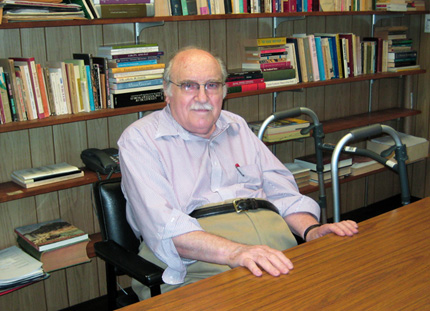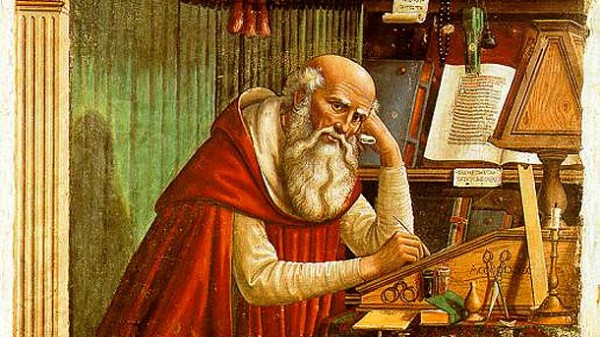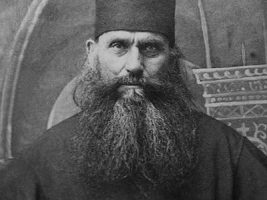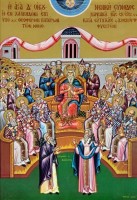
Photo: Lainie Rusco
I taught medieval history at Wichita State University, KS, and I am a translator. When I get stuck in a stubborn paragraph, I say a short Latin prayer to the Holy Spirit: “Veni, Sancte Spiritus; et emitte coelitus lucis tuae radium. Veni, pater pauperum; veni, dator munerum; veni, lumen cordium.” “Come, Holy Spirit, and send a ray of your heavenly light. Come, Father of the poor. Come, Giver of gifts, Come, Light of the hearts.”
In this article, I will first deal briefly with my own life, and then with one key aspect of patristic theology that continues to attract me. After discussing the practice of translation, I will answer questions that may arise. I was a tenured member of the faculty, but my life lacked a sense of direction. And then, mindful of the words of Socrates (c. 469-399 B.C.E.) in Plato’s Apology that “the unexamined life is not worth living,” I concluded that I had not really used the gift God had given me, that of languages. I had studied ten. Instead of going to church on Sundays, I listened to classical music, or read poetry by the German poets Rilke or Hölderlin. Then, unexpectedly, a former student invited me to Pascha at St George Orthodox Church. I converted to Orthodoxy in 1981.
I translate books out of a deep respect for Tradition. I know that various definitions may be given of that venerable word “Tradition,” but the one I like best is offered by the fifth-century French monk Vincent of Lérins in his renowned Commonitorium (c. 434). Using Latin, the language of his day, Vincent writes: “Id teneamus quod ubique, quod semper, quod ab omnibus creditum est.” In translation, “We use the greatest care to hold what has been believed everywhere, always, and by all.” (Documents of the Christian Church, ed. by H. Bettenson [1963] 84).
A concept that is essential in understanding Orthodoxy is that of “the heart.” Gregory of Nyssa (c. 335-394) wrote: “God is promised to the vision of those whose heart has been purified. But No man hath seen God at any time, as says the great John…[God] is the slippery, steep rock that affords no basis for our thoughts” (Ancient Christian Writers 18 [1954] 143, translated by Hilda Graef). And thus, God cannot be “understood” by the mind, though He can be understood by the heart, and be loved. In the text, On the Soul and the Resurrection, Macrina, Gregory’s sister, states admirably, “hé de gnósis agapé ginetai,” “knowledge becomes love” (The Fathers of the Church [1967] 240, translated by Virginia W. Callahan). Another possible translation might be “Love itself becomes knowledge”— “Amor ipse fit cognitio,” as was said in the Latin Middle Ages. There is an intellectual knowledge, and there is also knowledge as an experience of God in the heart, by grace.
Eastern spirituality appeals to the heart. We learn about “guarding of the heart” (in Greek, phulaké kardias; in Latin, custodia cordis), vigilance or watchfulness of the heart (népsis), purity of the heart (in Latin, puritas cordis), andkardiognésis (Greek for knowledge of the heart). In Scripture, the heart (lev, in Hebrew) is the point of contact between God and the human being. It gives stability to the successive, fleeting moments of life. In Orthodox Spirituality(1994), Bishop Hierotheos succinctly states that “the heart is the place . . . wherein God is revealed” (35). And to repeat what Tomaš Špidlík says in volume two of The Spirituality of the Christian East (2005, Cistercian Studies Series206), while commenting on Theophan the Recluse’s view of the degree of kinship between the human being and God (srodstvo, as Theophan says), “To be attentive to the voice of this ‘connaturality’ is to perceive the divine mysteries . . . as they enter our lives. The heart then becomes a wellspring of revelation” (258).
Moving away from the heart, let us now deal with “the head,” and the more technical aspects of translation. And thus, we ask, “exactly, what is translation?” It is not a mechanical act, like pouring wine from one bottle into another; nor is it a “reproduction” (in French, un calque). Rather, it is the process by which the original text, conventionally called “the Source Text,” is rewritten into its “dynamic equivalent” (the “Target Text”). This means that the crux of the translation process consists in writing a new version that shows fidelity (in German, Sinntreue) to the original. A good translator, then, does not render word for word (in Latin, verbum de verbo) but always meaning for meaning (sensus pro sensu), as St Jerome (c. 340420), the patron saint of translators, stated. Finding the correct meaning is a major task performed by the human translator, not by a machine. The unit of translation is always the paragraph, not the individual line.
One may ask, “What, then, is a translator?” Someone who rewrites “a book-in-itself” as “a book-for-others. Translators provide an important service to the reader—that of removing barriers. Translators make bridges. Translators work in the spaces between languages, and in so doing, provide a new perspective, a new way of thinking across language barriers.
If someone were to say, “I recently read that ‘a translation is an interpretation’”—would you agree? I might add that before making the translation, the translator performs an interpretive reading of the original text. Like everything we do, including the gestures we make, reading, almost by definition, involves “interpretation.” The translator does a great deal of research into the significance of certain words at a given historical period and in a certain cultural or religious ambiance (the German word is Umwelt, “the surrounding world”). What we should remember, then, is that a theological translation must always be faithful to the original. As stated earlier, this is the requirement of fidelity, ofSinntreue (Zingetrouwheid, in Dutch). A translator interacts with words, but he must always follow the road traveled by the author, just as the latter should follow the direction indicated by Scripture, the Church Fathers, and by Christ. The direction is always to the East: “Ex Oriente lux. Light comes from the East.” To conclude, then, a translator is not free to “recreate the original,” or distort the basic text by his own interpretation. If he does, he deserves the reproach of the Italian play on words, Traddutore-Traditore (“Translator-Traitor”).
The reader may wonder, “Are you working on something currently?” At present, in view of a translation, I am rereading a key work by the French Jesuit Jean Cardinal Daniélou (1905-1974), who defended his doctoral dissertation on Gregory of Nyssa (c.335-394) at the Sorbonne, Paris, in 1943. Together with Völker, the German scholar, Daniélou launched a Gregory of Nyssa renaissance in Europe in the 1950s, with the publication of a series of articles in scholarly Journals. He views Gregory as the real founder of mystical theology, defined as “a sensing of God in the soul.” The title of Daniélou’s study is Platonisme et théologie mystique. La doctrine spirituelle de saint Grégoire de Nysse (Aubier [1944] 326 pages). In translation, Platonism and Mystical Theology. The Spiritual Doctrine of Saint Gregory of Nyssa. This is an important work. In Ancient Christian Writers number 18 (New York [l954]), Hilda C. Graef, the translator, states that “It is only in recent times that Gregory of Nyssa has been rediscovered as an ascetical and mystical writer of the highest importance, witness the brilliant study which Père Daniélou devoted to this side of his work” (6). My translation will hopefully be the only truly comprehensive work available in English on all aspects of Gregory’s mystical theology. Is this arrogance? No, because of the warning given by Bernardus Silvestris (eleventh century) that the translator is only “a dwarf sitting on the shoulder of the giant.”
Someone may ask, “Is there a certain author’s work that you particularly enjoyed translating?” I would reply by mentioning, if I may, not one but two authors, the first being Tomaš Špidlik (1919-2010), a Jesuit Cardinal of the Roman Church, and professor of Eastern Patristics in Rome. I never met him, though I briefly corresponded with him. He knew Eastern theology superbly well; he was the star student of his professor, Irénée Hausherr, from Brussels, Belgium, a pioneer in the teaching of Eastern spirituality at the Pontifical Institute of Oriental studies in Rome. I translated two of Špidlik’s works: The Spirituality of the ChristianEast, Volume One (1986) and Volume Two (2005). We remember that an excerpt from Špidlik’s book, The Art of Purifying the Heart is found on pages 26-27 of the Spring 2011 issue of Jacob’s Well. Špidlik viewed the Church, not in terms of a historically false Roman triumphalism (“We are the true church”), but as part of the tradition of the universal, undivided Church, the mystical body, an extension of the body of Christ. He liked the word tserkovnost’, a word that is hard to translate, “a sense of Church, the desire and the will to live with and in her” (The Spirituality, vol. one, 157). Every author has his favorite vocabulary. Špidlik was very fond of using the term mysticism. There is, he stated, “the mysticism of the Church,” “the mysticism of light,” “the mysticism of events,” and the “mysticism of the heart.” (Index, The Spirituality, vol. two, 500).
The second author I enjoyed translating is Paul Evdokimov (1901-1970), a Russian lay theologian, who may be viewed as the real bridge between East and West. Born in 1901, in St Petersburg, Evdokimov first went to military school, and in 1918, attended the Academy of theology in Kiev. After the Revolution, his family settled in Paris in 1923, where he studied at the Sorbonne. In 1942, he completed his doctorate at the University of Aixen-Provence with a dissertation on Dostoevsky. He obtained a second Doctorate in theology from the St Sergius Institute, in Paris, in 1965. Together with figures such as Nicholas Afanasiev, Sergius Bulgakov, Elisabeth Behr-Sigel, and others, Evdokimov belongs to the group of émigré scholars in Paris who created what is often called “the Russian theological Renaissance.” Today, this important movement is being studied more and more, as is evidenced by the Cambridge Companion to Orthodox Christian Theology (2008). I translated three of Evdokimov’s books: Le sacrament de l’amour. The Sacrament of Love (SVS Press, 1985), La femme et le salut du monde. Woman and the Salvation of the World. A Christian Anthropology of the Charisms of Women (SVS Press, 1994), and his almost monumental Orthodoxie. Orthodoxy: the Transformed Cosmos, which is in press by Eighth Day Books in Wichita, KS.
Finally, one may wonder, “Why write translations at all?” Here is the answer: we translate because translations help raise the level of historical literacy among the readers. Also, we translate because of our love of words and of rhetoric or structure. As the heirs of Plato and Homer, most Church Fathers, educated in the classical tradition, wrote well. That is, they said simple things simply and complex things clearly.
God’s grace was revealed to me in the form of two presses for which I would translate books: St Vladimir’s Seminary Press in Crestwood, NY, and Cistercian Publications, then at Western Michigan University, in Kalamazoo, MI. I am deeply aware that God’s grace has been at work in my life as a professor and translator, and for this I bow my head in gratitude. I also know that my life does not yet form a complete unity, and that this will be an ongoing struggle until my death.
The thirteen books I have translated were written in French or German by great scholars: Irénée Hausherr and his Czech student, Tomaš Špidlík, both of whom taught Eastern spirituality in Rome; the Russians Boris Bobrinskoy, Paul Evdokimov, Bishop Krivochéine, and Leonid Ouspensky; Placide Deseille, a French Cistercian monk first at Bellefontaine and later at Aubazine in south-central France. In l977, he and his community joined the Orthodox Church on Mount Athos; and Gabriel Bunge, the Benedictine specialist on Evagrius of Pontus (343-399), who has recently been received into the Orthodox Church, in Russia. I worked with Fr John Meyendorff, the renowned Orthodox Church historian, in the sense that I translated several books which Fr Meyendorff had recommended to the Board of Publications at St Vladimir’s Seminary. Also, together with Professor and now Fr John Erickson, I edited Meyendorff’s book, Imperial Unity and Christian Divisions: The Church 450-680 A.D. (SVS Press [1989]), a work which Jaroslav Pelikan, then at Yale University, described as “a remarkable achievement.”
Why, then, are the books written by these giants of learning and holiness so important? Because they clarify the Tradition of the Fathers, and in this context, we can never emphasize too strongly that Western or Latin-speaking Christendom originated from the Greek Tradition, as a branch grows from a tree. The tree came first. Also, translators are very conscious of the fact that what they do is part of the always needed “return to the sources” (in French,ressourcement). We know what these sources of grace are: Scripture and the Patristic Testimony. The main virtue a translator should cultivate is that of obedience: to Christ (2 Cor 10:5), to the mind (in Greek, nous) is illumined by the Holy Tradition, and especially the mind of the Fathers. It cannot be denied that translators help to make patristic theology relevant to our modern world.
As second author (in Latin, auctor secundus) ,the translator is an earthly channel of God’s grace, linking one culture, religious or social, to another. The discipline required by translation, and the grace linked to the transmission of texts have created a certain unity in my life. And I know that some of my translations have helped certain readers find the grace of God in the center of the soul, their heart, where God meets the human being. It is well worth repeating that, while reading a text, one may become conscious of the grace of God.
Translators open new worlds of ideas, and yet,in the end, both the believer and the translator must, like Timothy (1 Tim 6:20), “guard the deposit.” This too is a work of grace, to be performed not only by the hierarchy—bishops, priests, deacons, monks and nuns—but by believers the world over.
The words the French author, Georges Bernanos (1888-1948), wrote in one of his novels, “Tout est grâce. Everything is grace,” apply in particular to the slow, painstaking work of translation. But we can perform this labor of love because our sluggish mind (in Greek, nous) is illumined by the Holy Spirit. Hence the crucial importance of the words of prayer from the Liturgy of the Presanctified Gifts: “Enlighten the eyes of our hearts with your truth.”
Professor Anthony Gythiel (+2014) was born in Belgium, and lost part of his family (mother, grandmother) to Nazi bombardment as the War broke out. He lived in Flanders, almost on the French border, on the way to Dunkirk, in Northern France and then lost everything in the revolution of June 1960, in Zaire, Africa, the former Belgian Congo, now called the Democratic Republic of the Congo, where he worked as a Catholic missionary. Coming to the United States he obtained the MA and then the PhD in 1971 in medieval comparative studies from the University of Detroit. He married, became an American citizen in 1968, and was tenured in the English department at Wichita State University, in KS; received various Teaching Awards (four altogether), and in 1993 became of Full Professor in the Department of History. He converted to Orthodoxy in 1981. On May 21, 2008, he received an Honorary Doctor of Divinity degree from St Vladimir’s Seminary in Crestwood, NY, for his translation work.
Originally published in Jacob’s Well, Winter 2012.

















